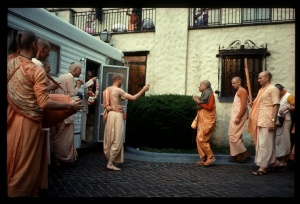CC Madhya 17.156: Difference between revisions
m (1 revision(s)) |
No edit summary |
||
| Line 1: | Line 1: | ||
{{ | [[Category:Sri Caitanya-caritamrta - Madhya-lila Chapter 17|C156]] | ||
<div style="float:left">'''[[Sri Caitanya-caritamrta|Śrī Caitanya-caritāmṛta]] - [[CC Madhya|Madhya-līlā]] - [[CC Madhya 17|Chapter 17: The Lord Travels to Vṛndāvana]]'''</div> | |||
<div style="float:right">[[File:Go-previous.png|link=CC Madhya 17.155|Madhya-līlā 17.155]] '''[[CC Madhya 17.155|Madhya-līlā 17.155]] - [[CC Madhya 17.157|Madhya-līlā 17.157]]''' [[File:Go-next.png|link=CC Madhya 17.157|Madhya-līlā 17.157]]</div> | |||
{{CompareVersions|CC|Madhya 17.156|CC 1975|CC 1996}} | |||
{{RandomImage}} | |||
==== TEXT 156 ==== | ==== TEXT 156 ==== | ||
<div | <div class="verse"> | ||
mathurā āsiyā kailā ‘viśrānti-tīrthe’ snāna | :mathurā āsiyā kailā ‘viśrānti-tīrthe’ snāna | ||
‘janma-sthāne’ ‘keśava’ dekhi’ karilā praṇāma | :‘janma-sthāne’ ‘keśava’ dekhi’ karilā praṇāma | ||
</div> | </div> | ||
| Line 12: | Line 16: | ||
==== SYNONYMS ==== | ==== SYNONYMS ==== | ||
<div | <div class="synonyms"> | ||
mathurā | ''mathurā āsiyā''—coming in to Mathurā; ''kailā''—performed; ''viśrānti-tīrthe''—at the bathing place known as Viśrāma-ghāṭa; ''snāna''—bathing; ''janma-sthāne''—at the place of Lord Kṛṣṇa’s birth; ''keśava''—the Deity named Keśava; ''dekhi’''—seeing; ''karilā praṇāma''—offered His respectful obeisances. | ||
</div> | </div> | ||
| Line 19: | Line 23: | ||
==== TRANSLATION ==== | ==== TRANSLATION ==== | ||
<div | <div class="translation"> | ||
When Śrī Caitanya Mahāprabhu entered the city of Mathurā, He took His bath at Viśrāma-ghāṭa. He then visited the birthplace of Kṛṣṇa and saw the Deity named Keśavajī. He offered His respectful obeisances to this Deity. | When Śrī Caitanya Mahāprabhu entered the city of Mathurā, He took His bath at Viśrāma-ghāṭa. He then visited the birthplace of Kṛṣṇa and saw the Deity named Keśavajī. He offered His respectful obeisances to this Deity. | ||
</div> | </div> | ||
| Line 26: | Line 30: | ||
==== PURPORT ==== | ==== PURPORT ==== | ||
<div | <div class="purport"> | ||
At the present moment, the temple of Keśavajī is very much improved. At one time, Keśavajī-mandira was attacked by the emperor Aurangzeb, who constructed such a big mosque there that the temple of Keśavajī was insignificant in comparison. But with the help of many rich Marwaris, the temple has been improved, and a very large temple is now being constructed so that the mosque is now appearing diminished in comparison. Many archeological discoveries have been made there, and many people from foreign countries are beginning to appreciate Kṛṣṇa’s birthplace. This Kṛṣṇa consciousness movement is attracting many foreigners to the Keśavajī temple, and now they will also be attracted by the Kṛṣṇa-Balarāma temple in Vṛndāvana. | At the present moment, the temple of Keśavajī is very much improved. At one time, Keśavajī-mandira was attacked by the emperor Aurangzeb, who constructed such a big mosque there that the temple of Keśavajī was insignificant in comparison. But with the help of many rich Marwaris, the temple has been improved, and a very large temple is now being constructed so that the mosque is now appearing diminished in comparison. Many archeological discoveries have been made there, and many people from foreign countries are beginning to appreciate Kṛṣṇa’s birthplace. This Kṛṣṇa consciousness movement is attracting many foreigners to the Keśavajī temple, and now they will also be attracted by the Kṛṣṇa-Balarāma temple in Vṛndāvana. | ||
</div> | </div> | ||
__NOTOC__ | |||
<div style="float:right; clear:both;">[[File:Go-previous.png|link=CC Madhya 17.155|Madhya-līlā 17.155]] '''[[CC Madhya 17.155|Madhya-līlā 17.155]] - [[CC Madhya 17.157|Madhya-līlā 17.157]]''' [[File:Go-next.png|link=CC Madhya 17.157|Madhya-līlā 17.157]]</div> | |||
__NOTOC__ | |||
__NOEDITSECTION__ | |||
Revision as of 15:33, 24 October 2021

A.C. Bhaktivedanta Swami Prabhupada
TEXT 156
- mathurā āsiyā kailā ‘viśrānti-tīrthe’ snāna
- ‘janma-sthāne’ ‘keśava’ dekhi’ karilā praṇāma
SYNONYMS
mathurā āsiyā—coming in to Mathurā; kailā—performed; viśrānti-tīrthe—at the bathing place known as Viśrāma-ghāṭa; snāna—bathing; janma-sthāne—at the place of Lord Kṛṣṇa’s birth; keśava—the Deity named Keśava; dekhi’—seeing; karilā praṇāma—offered His respectful obeisances.
TRANSLATION
When Śrī Caitanya Mahāprabhu entered the city of Mathurā, He took His bath at Viśrāma-ghāṭa. He then visited the birthplace of Kṛṣṇa and saw the Deity named Keśavajī. He offered His respectful obeisances to this Deity.
PURPORT
At the present moment, the temple of Keśavajī is very much improved. At one time, Keśavajī-mandira was attacked by the emperor Aurangzeb, who constructed such a big mosque there that the temple of Keśavajī was insignificant in comparison. But with the help of many rich Marwaris, the temple has been improved, and a very large temple is now being constructed so that the mosque is now appearing diminished in comparison. Many archeological discoveries have been made there, and many people from foreign countries are beginning to appreciate Kṛṣṇa’s birthplace. This Kṛṣṇa consciousness movement is attracting many foreigners to the Keśavajī temple, and now they will also be attracted by the Kṛṣṇa-Balarāma temple in Vṛndāvana.